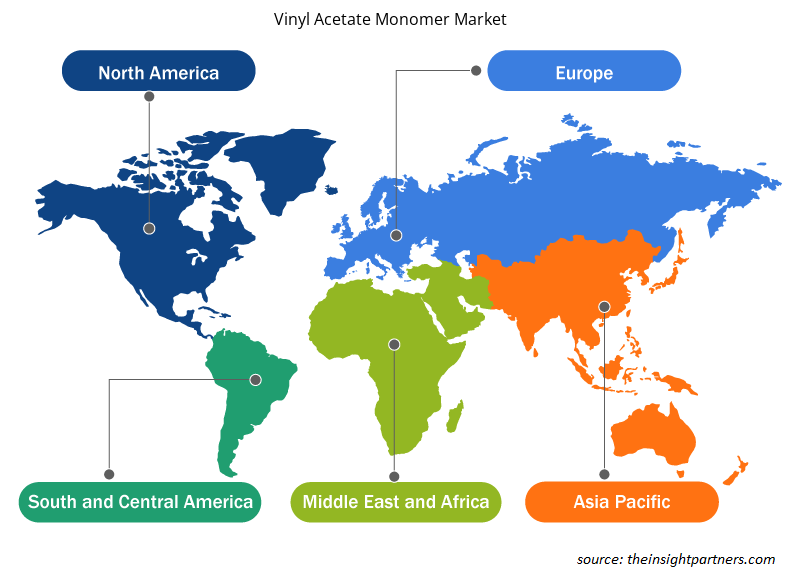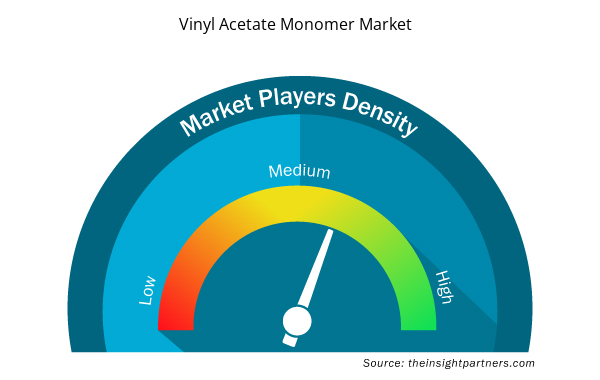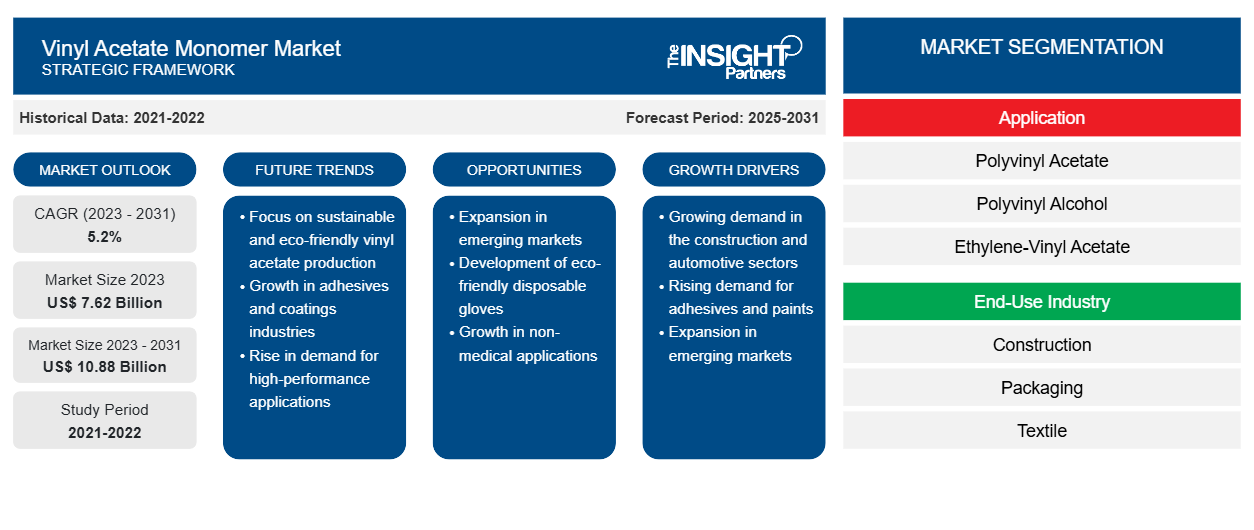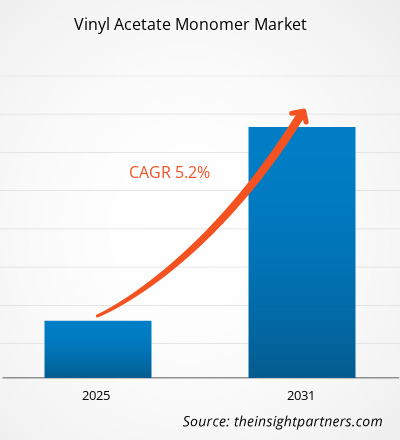Der Markt für Vinylacetatmonomere soll von 7,62 Milliarden US-Dollar im Jahr 2023 auf 10,88 Milliarden US-Dollar im Jahr 2031 anwachsen. Der Markt wird voraussichtlich zwischen 2023 und 2031 eine durchschnittliche jährliche Wachstumsrate von 5,2 % verzeichnen. Die wachsende Nachfrage aus verschiedenen Endverbrauchsbranchen dürfte weiterhin ein wichtiger Trend auf dem Markt für Vinylacetatmonomere bleiben.
Marktanalyse für Vinylacetat-Monomer
Der Markt wird in erster Linie von Faktoren wie der steigenden Nachfrage nach Vinylacetatmonomer aus verschiedenen Endverbrauchsbranchen getrieben. Vinylacetatmonomer (VAM) ist ein wichtiges Zwischenprodukt zur Herstellung einer Reihe von Polymeren und Harzen. Vinylacetatmonomer ist ein wichtiger Rohstoff zur Herstellung von Chemikalien, die dann zur Herstellung einer breiten Palette von Verbraucher- und Industrieprodukten verwendet werden. Polyvinylacetat hat starke Hafteigenschaften für verschiedene Materialien, darunter Papier, Holz, Kunststofffolien und Metalle. Diese Faktoren treiben den globalen Markt für Vinylacetatmonomer weltweit maßgeblich an.
Marktübersicht für Vinylacetat-Monomer
Der Markt für Vinylacetatmonomer ist ein wichtiger Bereich der chemischen Industrie. Vinylacetatmonomer ist ein wichtiger Baustein bei der Synthese verschiedener Polymere und Harze wie Polyvinylacetat (PVA), Polyvinylalkohol (PVOH) und Ethylen-Vinylacetat -Copolymer (EVA). Diese Materialien werden häufig in Bereichen wie Klebstoffen, Farben, Beschichtungen, Textilien und Verpackungen verwendet. Zu den Faktoren, die den weltweiten Markt für Vinylacetatmonomer beeinflussen, gehören wirtschaftliche Expansion, Industrialisierung und technologischer Fortschritt.
Passen Sie diesen Bericht Ihren Anforderungen an
Sie erhalten kostenlos individuelle Anpassungen an jedem Bericht, einschließlich Teilen dieses Berichts oder einer Analyse auf Länderebene, eines Excel-Datenpakets sowie tolle Angebote und Rabatte für Start-ups und Universitäten.
- Holen Sie sich die wichtigsten Markttrends aus diesem Bericht.Dieses KOSTENLOSE Beispiel umfasst eine Datenanalyse von Markttrends bis hin zu Schätzungen und Prognosen.
Markttreiber und Chancen für Vinylacetat-Monomer
Wachsende Nachfrage aus verschiedenen Endverbrauchsbranchen
Vinylacetatmonomer ist ein wesentlicher Rohstoff bei der Herstellung vieler Polymere und Harze. Vinylacetatmonomer ist der wichtigste Rohstoff für die Herstellung von Polyvinylacetat (PVA), Polyvinylalkohol (PVOH), Ethylenvinylacetat (EVA) usw. Polyvinylacetat hat starke Hafteigenschaften für verschiedene Materialien, darunter Papier, Holz, Kunststofffolien und Metalle. Es ist auch ein wichtiger Bestandteil von Holzleim, Weißleim, Tischlerleim und Schulleim. Polyvinylalkohol wird für selbstklebende Verpackungsfolien verwendet. Die steigende Nachfrage nach Klebstoffen aus verschiedenen Branchen wie dem Baugewerbe, der Möbelindustrie usw. treibt das Marktwachstum voran.
Steigende Auslastung in der Elektronikfertigung
Ethylen-Vinylacetat ist ein thermoplastisches Polymer, das in Solarzellen/-modulen als Verkapselungsmittel verwendet wird. Ethylen-Vinylacetat ist eines der am häufigsten verwendeten Verkapselungsmaterialien für Photovoltaikmodule. Das Photovoltaikmodul mit dieser Art der Verkapselung schützt die Zellen vor mechanischer Beschädigung und Feuchtigkeitseintritt. Verkapselungsfolien spielen eine wichtige Rolle dabei, das Eindringen von Wasser und Schmutz in Solarmodule zu verhindern . Ethylen-Vinylacetat wird zunehmend zur Verkapselung von Solarmodulen verwendet, da es verschiedene für Solarmodule gewünschte Eigenschaften aufweist, wie z. B. einen hohen elektrischen Widerstand, geringe Wasseraufnahme, hervorragende optische Übertragung, gute Klebeeigenschaften, hohe Elastizität usw.
Segmentierungsanalyse des Vinylacetatmonomer-Marktberichts
Das Schlüsselsegment, das zur Ableitung der Marktanalyse für Vinylacetatmonomer beigetragen hat, ist die Qualität.
- Basierend auf der Anwendung ist der Markt für Vinylacetatmonomer in Polyvinylacetat (PVA), Polyvinylalkohol (PVOH), Ethylen-Vinylacetat (EVA) und andere unterteilt. Das Untersegment Polyvinylacetat (PVA) hatte im Jahr 2023 einen größeren Marktanteil.
- Basierend auf der Endverbrauchsbranche ist der Markt für Vinylacetatmonomer in die Bereiche Bau, Verpackung, Textil und Sonstige unterteilt. Das Untersegment Bau hielt im Jahr 2023 einen größeren Marktanteil.
Marktanteilsanalyse für Vinylacetat-Monomer nach geografischer Lage
Der geografische Umfang des Marktberichts für Vinylacetat-Monomer ist hauptsächlich in fünf Regionen unterteilt: Nordamerika, Asien-Pazifik, Europa, Naher Osten und Afrika sowie Südamerika/Süd- und Mittelamerika.
Der asiatisch-pazifische Raum erlebt einen Aufschwung aufgrund der zunehmenden Urbanisierung und des starken Wachstums der Automobil- und Baubranche, was den wichtigsten Marktteilnehmern auf dem Vinylacetatmonomermarkt reichlich Gelegenheiten bietet. Daher wird erwartet, dass der Anstieg der Bautätigkeiten die Expansion des globalen Vinylacetatmonomermarktes in den kommenden Jahren weiter vorantreiben wird.
Regionale Einblicke in den Vinylacetatmonomermarkt
Die regionalen Trends und Faktoren, die den Vinylacetatmonomer-Markt während des Prognosezeitraums beeinflussen, wurden von den Analysten von Insight Partners ausführlich erläutert. In diesem Abschnitt werden auch die Marktsegmente und die Geografie des Vinylacetatmonomers in Nordamerika, Europa, im asiatisch-pazifischen Raum, im Nahen Osten und Afrika sowie in Süd- und Mittelamerika erörtert.

- Erhalten Sie regionale Daten zum Vinylacetatmonomermarkt
Umfang des Marktberichts über Vinylacetatmonomer
| Berichtsattribut | Details |
|---|---|
| Marktgröße im Jahr 2023 | 7,62 Milliarden US-Dollar |
| Marktgröße bis 2031 | 10,88 Milliarden US-Dollar |
| Globale CAGR (2023 - 2031) | 5,2 % |
| Historische Daten | 2021-2022 |
| Prognosezeitraum | 2025–2031 |
| Abgedeckte Segmente | Nach Anwendung
|
| Abgedeckte Regionen und Länder | Nordamerika
|
| Marktführer und wichtige Unternehmensprofile |
|
Marktteilnehmerdichte für Vinylacetatmonomer: Auswirkungen auf die Geschäftsdynamik verstehen
Der Markt für Vinylacetatmonomere wächst rasant, angetrieben durch die steigende Endverbrauchernachfrage aufgrund von Faktoren wie sich entwickelnden Verbraucherpräferenzen, technologischen Fortschritten und einem größeren Bewusstsein für die Vorteile des Produkts. Mit steigender Nachfrage erweitern Unternehmen ihr Angebot, entwickeln Innovationen, um die Bedürfnisse der Verbraucher zu erfüllen, und nutzen neue Trends, was das Marktwachstum weiter ankurbelt.
Die Marktteilnehmerdichte bezieht sich auf die Verteilung von Firmen oder Unternehmen, die in einem bestimmten Markt oder einer bestimmten Branche tätig sind. Sie gibt an, wie viele Wettbewerber (Marktteilnehmer) in einem bestimmten Marktraum im Verhältnis zu seiner Größe oder seinem gesamten Marktwert präsent sind.
Die wichtigsten auf dem Markt für Vinylacetat-Monomer tätigen Unternehmen sind:
- Celanese Corporation
- Chang Chun Gruppe
- China Petroleum & Chemical Corporation
- Dairen Chemical Corporation
- Japan VAM & POVAL Co. Ltd
Haftungsausschluss : Die oben aufgeführten Unternehmen sind nicht in einer bestimmten Reihenfolge aufgeführt.

- Überblick über die wichtigsten Akteure auf dem Vinylacetat-Monomer-Markt
Neuigkeiten und aktuelle Entwicklungen zum Vinylacetat-Monomer-Markt
Der Markt für Vinylacetatmonomer wird durch die Erhebung qualitativer und quantitativer Daten nach Primär- und Sekundärforschung bewertet, die wichtige Unternehmensveröffentlichungen, Verbandsdaten und Datenbanken umfasst. Im Folgenden finden Sie eine Liste der Entwicklungen auf dem Markt für Vinylacetatmonomer und Strategien:
- Dairen Chemical beabsichtigt, die VAM-Produktion im Werk Mayliao im März einzustellen. (Quelle: Dairen Chemical, Website, 2024)
- Die Celanese Corporation gab den Abschluss einer Initiative mit extrem geringem Kapitaleinsatz bekannt, bei der bestehende Produktions- und Infrastrukturanlagen umfunktioniert werden, um zusätzliche Ethylenvinylacetat-(EVA-)Kapazitäten an ihrem Standort in Edmonton, Alberta, zu schaffen. Die Entwicklung wird dazu beitragen, das nachgelagerte Vinylangebot der Acetylkette erheblich zu erweitern. (Quelle: Celanese Corporation, News, 2023)
Marktbericht zu Vinylacetat-Monomer – Umfang und Ergebnisse
Der Bericht „Marktgröße und Prognose für Vinylacetat-Monomer (2021–2031)“ bietet eine detaillierte Analyse des Marktes, die die folgenden Bereiche abdeckt:
- Marktgröße und Prognose auf globaler, regionaler und Länderebene für alle wichtigen Marktsegmente, die im Rahmen des Projekts abgedeckt sind
- Marktdynamik wie Treiber, Beschränkungen und wichtige Chancen
- Wichtige Zukunftstrends
- Detaillierte PEST/Porters Five Forces- und SWOT-Analyse
- Globale und regionale Marktanalyse mit wichtigen Markttrends, wichtigen Akteuren, Vorschriften und aktuellen Marktentwicklungen
- Branchenlandschaft und Wettbewerbsanalyse, einschließlich Marktkonzentration, Heatmap-Analyse, prominenten Akteuren und aktuellen Entwicklungen
- Detaillierte Firmenprofile
- Historische Analyse (2 Jahre), Basisjahr, Prognose (7 Jahre) mit CAGR
- PEST- und SWOT-Analyse
- Marktgröße Wert/Volumen – Global, Regional, Land
- Branche und Wettbewerbsumfeld
- Excel-Datensatz



Report Coverage
Revenue forecast, Company Analysis, Industry landscape, Growth factors, and Trends

Segment Covered
This text is related
to segments covered.

Regional Scope
North America, Europe, Asia Pacific, Middle East & Africa, South & Central America

Country Scope
This text is related
to country scope.
Trends and growth analysis reports related to Chemicals and Materials : READ MORE..
The Insight Partners performs research in 4 major stages: Data Collection & Secondary Research, Primary Research, Data Analysis and Data Triangulation & Final Review.
- Data Collection and Secondary Research:
As a market research and consulting firm operating from a decade, we have published and advised several client across the globe. First step for any study will start with an assessment of currently available data and insights from existing reports. Further, historical and current market information is collected from Investor Presentations, Annual Reports, SEC Filings, etc., and other information related to company’s performance and market positioning are gathered from Paid Databases (Factiva, Hoovers, and Reuters) and various other publications available in public domain.
Several associations trade associates, technical forums, institutes, societies and organization are accessed to gain technical as well as market related insights through their publications such as research papers, blogs and press releases related to the studies are referred to get cues about the market. Further, white papers, journals, magazines, and other news articles published in last 3 years are scrutinized and analyzed to understand the current market trends.
- Primary Research:
The primarily interview analysis comprise of data obtained from industry participants interview and answers to survey questions gathered by in-house primary team.
For primary research, interviews are conducted with industry experts/CEOs/Marketing Managers/VPs/Subject Matter Experts from both demand and supply side to get a 360-degree view of the market. The primary team conducts several interviews based on the complexity of the markets to understand the various market trends and dynamics which makes research more credible and precise.
A typical research interview fulfils the following functions:
- Provides first-hand information on the market size, market trends, growth trends, competitive landscape, and outlook
- Validates and strengthens in-house secondary research findings
- Develops the analysis team’s expertise and market understanding
Primary research involves email interactions and telephone interviews for each market, category, segment, and sub-segment across geographies. The participants who typically take part in such a process include, but are not limited to:
- Industry participants: VPs, business development managers, market intelligence managers and national sales managers
- Outside experts: Valuation experts, research analysts and key opinion leaders specializing in the electronics and semiconductor industry.
Below is the breakup of our primary respondents by company, designation, and region:

Once we receive the confirmation from primary research sources or primary respondents, we finalize the base year market estimation and forecast the data as per the macroeconomic and microeconomic factors assessed during data collection.
- Data Analysis:
Once data is validated through both secondary as well as primary respondents, we finalize the market estimations by hypothesis formulation and factor analysis at regional and country level.
- Macro-Economic Factor Analysis:
We analyse macroeconomic indicators such the gross domestic product (GDP), increase in the demand for goods and services across industries, technological advancement, regional economic growth, governmental policies, the influence of COVID-19, PEST analysis, and other aspects. This analysis aids in setting benchmarks for various nations/regions and approximating market splits. Additionally, the general trend of the aforementioned components aid in determining the market's development possibilities.
- Country Level Data:
Various factors that are especially aligned to the country are taken into account to determine the market size for a certain area and country, including the presence of vendors, such as headquarters and offices, the country's GDP, demand patterns, and industry growth. To comprehend the market dynamics for the nation, a number of growth variables, inhibitors, application areas, and current market trends are researched. The aforementioned elements aid in determining the country's overall market's growth potential.
- Company Profile:
The “Table of Contents” is formulated by listing and analyzing more than 25 - 30 companies operating in the market ecosystem across geographies. However, we profile only 10 companies as a standard practice in our syndicate reports. These 10 companies comprise leading, emerging, and regional players. Nonetheless, our analysis is not restricted to the 10 listed companies, we also analyze other companies present in the market to develop a holistic view and understand the prevailing trends. The “Company Profiles” section in the report covers key facts, business description, products & services, financial information, SWOT analysis, and key developments. The financial information presented is extracted from the annual reports and official documents of the publicly listed companies. Upon collecting the information for the sections of respective companies, we verify them via various primary sources and then compile the data in respective company profiles. The company level information helps us in deriving the base number as well as in forecasting the market size.
- Developing Base Number:
Aggregation of sales statistics (2020-2022) and macro-economic factor, and other secondary and primary research insights are utilized to arrive at base number and related market shares for 2022. The data gaps are identified in this step and relevant market data is analyzed, collected from paid primary interviews or databases. On finalizing the base year market size, forecasts are developed on the basis of macro-economic, industry and market growth factors and company level analysis.
- Data Triangulation and Final Review:
The market findings and base year market size calculations are validated from supply as well as demand side. Demand side validations are based on macro-economic factor analysis and benchmarks for respective regions and countries. In case of supply side validations, revenues of major companies are estimated (in case not available) based on industry benchmark, approximate number of employees, product portfolio, and primary interviews revenues are gathered. Further revenue from target product/service segment is assessed to avoid overshooting of market statistics. In case of heavy deviations between supply and demand side values, all thes steps are repeated to achieve synchronization.
We follow an iterative model, wherein we share our research findings with Subject Matter Experts (SME’s) and Key Opinion Leaders (KOLs) until consensus view of the market is not formulated – this model negates any drastic deviation in the opinions of experts. Only validated and universally acceptable research findings are quoted in our reports.
We have important check points that we use to validate our research findings – which we call – data triangulation, where we validate the information, we generate from secondary sources with primary interviews and then we re-validate with our internal data bases and Subject matter experts. This comprehensive model enables us to deliver high quality, reliable data in shortest possible time.


 Holen Sie sich ein kostenloses Muster für diesen Bericht
Holen Sie sich ein kostenloses Muster für diesen Bericht